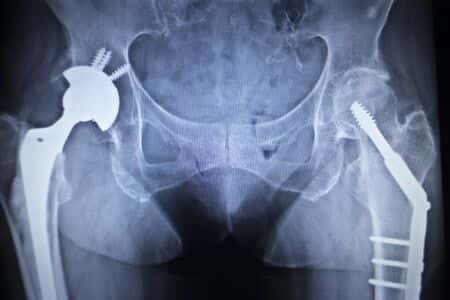Allegedly Defective Hip Implant Causes Metallosis in Patient
Updated on
This case involves an alleged defective hip implant. The plaintiff was a seventy-three-year-old female who experienced significant pain while walking. She consulted with her primary physician, who referred her to an orthopedic surgeon. The surgeon determined that a total hip replacement was required and she was scheduled for surgery. Four weeks later, the plaintiff underwent what was deemed a successful surgery. One year following the surgery, the plaintiff began feeling pain and swelling in her right hip, which resulted in difficulty walking. After two months of continual and progressive discomfort, she went back to the orthopedic surgeon to determine the cause of the pain. He determined that a significant amount of metallic debris had shed off into her body, resulting in metallosis. As a result, the plaintiff had to undergo revision surgery two weeks later to remove the implant. She likewise required long-term locomotor training in order to regain her balance and improve her movement.
Question(s) For Expert Witness
1. What are the symptoms of metallosis and what are the dangers of these symptoms to the body?
Expert Witness Response
![]() Metallosis results from the collection of metal particles that build up in the soft tissue of the body. When this occurs, the body’s immune system will identify the particles as foreign bodies and attack them. This causes inflammation along with a slew of other health issues for the patient. Specifically, the metal particles may release large amounts of cobalt and chromium into the bloodstream, which can cause the tissue to grey or decay in the area surrounding the implant. This may cause acute toxicity and a condition known as cobaltism, which is dangerous for the circulatory system, cognitive health, and organs. Additionally, these metal ions may also form what are known as pseudotumors. These pseudotumors are not actual tumors, but rather thickened nodules made up of inflamed cells and tissue filled with fluid. If these are not treated, they may cause osteolysis or self-destructive bone death. I am a medical toxicologist and I have over thirty years of experience in my specialty.
Metallosis results from the collection of metal particles that build up in the soft tissue of the body. When this occurs, the body’s immune system will identify the particles as foreign bodies and attack them. This causes inflammation along with a slew of other health issues for the patient. Specifically, the metal particles may release large amounts of cobalt and chromium into the bloodstream, which can cause the tissue to grey or decay in the area surrounding the implant. This may cause acute toxicity and a condition known as cobaltism, which is dangerous for the circulatory system, cognitive health, and organs. Additionally, these metal ions may also form what are known as pseudotumors. These pseudotumors are not actual tumors, but rather thickened nodules made up of inflamed cells and tissue filled with fluid. If these are not treated, they may cause osteolysis or self-destructive bone death. I am a medical toxicologist and I have over thirty years of experience in my specialty.
Subscribe to our newsletter
Join our newsletter to stay up to date on legal news, insights and product updates from Expert Institute.
Sign up nowFind an expert witness near you
What State is your case in?
Subscribe to our newsletter
Join our newsletter to stay up to date on legal news, insights and product updates from Expert Institute.


